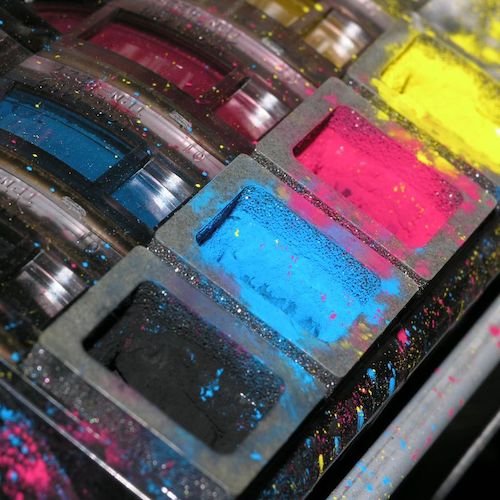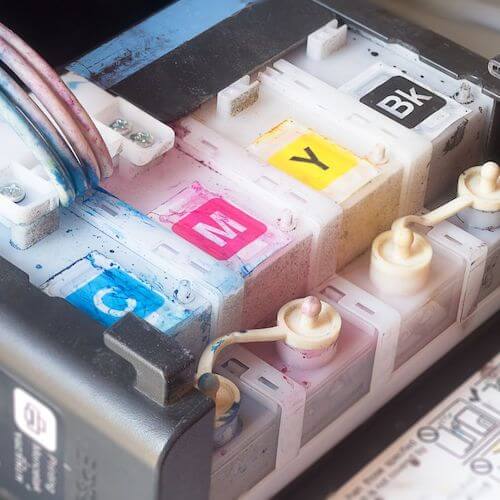
If you’re considering investing in a laser printer, or perhaps you’ve recently made the switch, one of your greatest concerns is the ongoing costs, in particular toner. You know that toner isn’t cheap, and you might be asking yourself: “How long does toner really last?”
Whether you print occasionally or run a bustling office with high print demands, understanding toner lifespan is crucial for budgeting and planning.
At Strategic Technology Partners of Texas (STPT), we’ve been working with laser printers for nearly 40 years and know everything there is to know about toner. We’re dedicated to providing you with the insights you need to make informed decisions about your printing supplies.
So, we’ve put together this blog to explain toner lifespan and everything you need to know about it. In this blog, we will delve into what printer toner is, how it compares to ink, and everything you need to know about its lifespan, types, costs, and even recycling. By the end, you’ll have a clear understanding of toner longevity and how to manage your toner usage effectively.
What is Printer Toner?
Let’s start with the basics: What is printer toner? In short, it’s a substance commonly in the form of a dry powder that laser printers and photocopiers use to create printed text and images. It consists of finely ground particles of plastic, carbon, and coloring agents. This mixture is stored in a cylindrical cartridge and is most commonly available in cyan, magenta, yellow, and black (CMYK). When mixed together, CMYK produces a variety of admixtures for printers.
What is a Printer Toner Cartridge?
A toner cartridge is a container that houses the toner powder and delivers it to the printer’s drum unit to produce text and images. Cartridges are typically made from a combination of plastic and metal components and include a sealed hopper to hold the toner, a drum unit to transfer the toner to the paper, and a wiper blade to clean the drum. In laser printers, the toner is heated and fused onto the paper, resulting in crisp, durable prints. When toner runs out, you’ll have to replace the entire cartridge.
Many people use the terms ink cartridge, print cartridge, and toner cartridge interchangeably when referring to the same item.
Different Types of Toners
There are four main types of toners:
- OEM (Original Equipment Manufacturer): These are produced by the original manufacturer of the printer and offer the best compatibility and reliability.
- Newly Manufactured Compatible Toners: Brands like Xerox Everyday Toner produce these cartridges, which are made to work with major printing brands like HP and Brother.
- Remanufactured Toners: These are recycled OEM cartridges that have been cleaned, refilled, and tested for quality.
- Drill and Fill Toners: Typically the least reliable, these involve simply drilling a hole into an empty cartridge and refilling it with toner powder.
For a deeper dive into these toner options, check out our dedicated blog on the 4 Different Types of Printer Toners.
How Long Does Toner Last?
To determine how long a toner cartridge will last, you will need to look at page yield. Page yield is the approximate number of pages a cartridge can print. Each toner cartridge has an estimated yield, which is published by the toner manufacturer. Page yield is calculated based on printing pages with 5% coverage, meaning that only 5% of the page is covered in toner. We’ll discuss how this impacts the price of toner in the following section.
Until 2004, manufacturers did not have a set standard for page yield, materials used, or testing procedures, which made comparing products challenging. However, in the early 2000s, the International Organization for Standardization (ISO) and the International Electrotechnical Commission (IEC) published official yield standards for monochrome toner cartridges, color inkjet cartridges, and color toner cartridges so that you could know what to expect from their printer toner.
For example:
- Standard Black Toner Cartridge: Approximately 2,500 pages.
- High-Yield Black Toner Cartridge: Approximately 6,000 pages.
These estimates can vary based on the type of documents you print. If you frequently print pages with heavy graphics or full-page text, your toner will deplete faster. Printer-toner compatibility and the type of toner cartridge you use will also impact your final page yield.
Does Printer Toner Expire?
While toner doesn't technically "expire" in the same way that food or medicine does, it does have a limited shelf life. Over time, toner powder can degrade, which can affect print quality and the performance of your printer.
Most toner cartridges have a shelf life of about 24 to 36 months when stored properly. The actual longevity can vary depending on factors like how and where you store your toner.
Signs of Expired Toner
Using expired toner can lead to several issues, including:
- Poor Print Quality: Prints may appear faded, streaky, or inconsistent.
- Clumping: Toner powder can clump together, which can cause jams and other mechanical issues in your printer.
- Incompatibility: Older toner may not work as effectively with newer printers, especially if the technology has advanced significantly since the toner was manufactured. Read our blog on using old supplies on new machines to learn more.
Extending the Life of Toner Cartridges
It’s important to note that there are no secret ways to extend the lifespan of toner beyond its estimated page yield. However, reducing unnecessary prints can significantly decrease toner consumption over time. Another effective strategy is to utilize draft mode for non-essential prints, thereby conserving toner.
Proper Storage of Toner
Proper storage is crucial for extending the life of your toner cartridges. Keep them in a cool, dry environment, away from direct sunlight and high humidity. This will prevent the toner from clumping or degrading. Ensure they are stored horizontally to prevent the toner from settling unevenly.
Automatic Toner Shipments
Managing multiple printers and keeping track of toner levels can be challenging, especially for businesses with several printers. Automatic toner shipments are a convenient solution. By enrolling in an automatic toner shipment program (for STPT customers, it comes as part of a maintenance plan), you can ensure that your printers never run out of toner. This service automatically sends you new toner cartridges when your current ones are running low based on your usage patterns.
Use the Right Toner
It’s also important to invest in high-quality toner that's specifically designed for your machine. Instead of rushing to find any generic toner, consider purchasing toner that's optimized for your printer. Using the right toner can help maximize the number of pages you can print and ensure quality results.
How Much Does Printer Toner Cost?
Put simply, a toner cartridge’s page yield is the number of pages you can print if text or image covers only 5% of each page. The higher the page yield, the higher the price of the toner cartridge.
Toner cost will vary based on the number of impressions a cartridge can produce to cover a fixed percent of the coverage area. In the U.S., 5% is the set standard, and all toner manufacturers are required to publish the page yield of each toner cartridge based on that standard.
See the graphic below, from Cartridge People, for a visual explanation of what 5% page coverage looks like:

If you are printing many pages with large images or dense full-page texts, then you likely are printing at a page coverage rate much higher than the standard, which means you may not be able to print as many pages as the page yield approximates. For more information on page coverage and how it is defined, check out our blog on What is Page Coverage and Why Is It Important?
The cost of toner varies based on the type and brand of the cartridge. On average:
- Standard Black Toner Cartridge: Around $50.
- Color Toner Cartridges: Can range from $60 to $150 each.
Laser toner cartridges may seem expensive at first, but they are more cost-effective in the long run. This is because they have a long lifespan and high page yield compared to ink cartridges. When choosing printer toner, many people only consider the price. However, focusing solely on the cost of laser printer cartridges can lead a consumer to look for cheaper options. A disreputable or off-brand toner can damage your printer if it is of low quality.
Printer Toner vs. Ink
Toner and ink serve the same basic function: making your documents and images visible on paper. However, the two are quite different in form and function. Toner is a powder used in laser printers, while ink is a liquid used in inkjet printers. Toner cartridges tend to be more expensive initially but offer a higher page yield.


When it comes to cost and yield, there are noteworthy differences between ink and toner cartridges. Printer ink can be purchased for around $15, whereas toner cartridges cost around $100 on average. However, in this case, price is not a clear indicator of value: toner cartridges yield approximately 2500 pages of printed text, and ink cartridges yield only about 200 printed pages. Again, these estimates will vary based on the ink/toner manufacturer and your printer model.
Another thing to consider when choosing between toner and ink cartridges is their shelf life. Ink cartridges are prone to clogging or drying up if not consistently used. If you are not using your printer every day, then your ink cartridge can dry out, which will decrease the possible page yield of the cartridge. If the ink dries out, then the cartridge becomes unusable, and you spend more money to buy a replacement ink cartridge sooner than expected.
Toner, on the other hand, is already a dry substance, so its shelf life is longer, even if you don’t use it consistently.
How to Dispose of Empty Cartridges
Once your toner cartridge is empty, don't just toss it in the trash. Recycling toner cartridges is an environmentally friendly option. Many manufacturers and office supply stores offer recycling programs.
To learn more about recycling toner cartridges and other printer supplies, check out our dedicated blog on ways to recycle toner cartridges.
Make The Most Out of Your Toner
Understanding the lifespan of your toner cartridges helps you manage your printing needs and expenses more effectively. Whether you’re considering OEM, compatible, or remanufactured toner, knowing your options and how to extend their life can save you time and money.
At Strategic Technology Partners of Texas (STPT), we’re committed to helping you find the perfect printing solutions. With over 35 years of experience, we offer expertise you can trust. For more tips on managing your office supplies and to explore our auto-toner shipment options, check out our blog on auto-toner shipments. This service is part of our maintenance plan and can simplify your toner replacements and keep your office running smoothly.
If you have any questions or need assistance finding the right toner for your needs, contact us today. Let us help you optimize your printing setup and ensure you never run out of toner again.
